- TOP
- Search Criteria
- A Photographic Guide to Koenji Awa Odori

STORY
Koenji Awa Odori, a Photographic Guide to Tokyo's Most Lively Festival
The dancers are fools
The watchers are fools
Both are fools alike so
Why not dance?
(Awa yoshikono, the Awa Odori song)
Every summer, over 10,000 dancers and over 1 million people gather in the streets of Koenji for the annual Awa Odori festival. This is one of the biggest, most lively and colorful festivals in Tokyo.

I have seen Awa Odori twice before, but I wanted to learn more about it. This year I had the chance to participate in an event organized by Breathe Tokyo that gives foreigners the possibility to join one of the dance groups. Here's my experience and what I learned about Awa Odori in the process!

Awa Odori or Awa dance originated in the Tokushima prefecture (formerly called Awa) back in 1587. There are several theories about the origin of this dance, many of which stating that it evolved from other folk dances. The most popular theory recounts of Hachisuka Iemasa, a feudal lord who threw a big party for the newly built Tokushima castle in 1587. Allegedly, so much sake was present at this party that the citizens started to dance in the streets, giving origin to Awa Odori. Regardless of this story being true or not, this is a festival worth seeing. Nowadays many other cities in Japan are holding their own Awa Odori festival so you might catch one if you visit Japan in summer.

The district of Koenji in Suginami ward adopted this festival back in 1957 to revitalize its streets. The Koenji Awa Odori is held every year on the last weekend of August and it is now the second largest Awa Odori festival in Japan. During the festival, groups of dancers called Ren parade through the streets around the station.
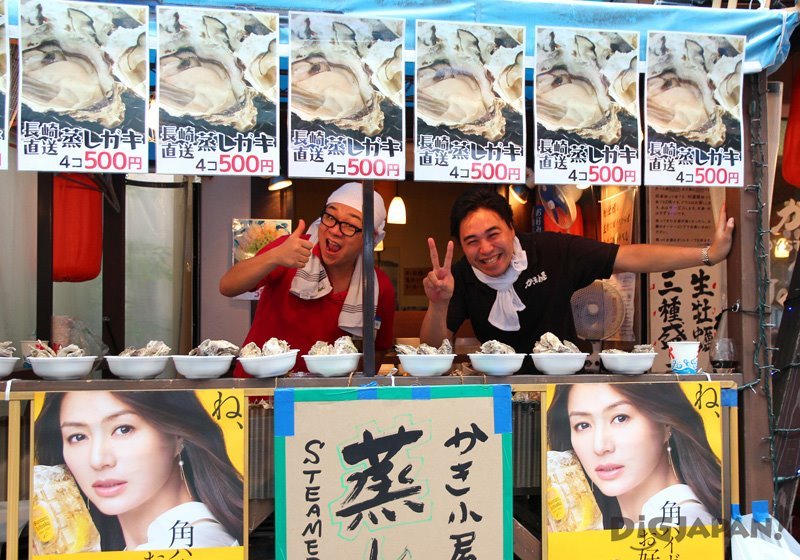
Any business in the area, no matter if it's a restaurant or a dry cleaner, will set up a little stand outside their shop selling food or drinks. The streets become lively with people eating and drinking and with the music from the parade.
There are several dancing styles in Awa Odori. We learned the most basic one, which can be danced by both men and women. It's basically a step-return pattern alternating between your right and left foot. I always thought this dance looked very easy and carefree, but it actually takes some strength and coordination.

First we were taught the basic position which is a squatting stance. Yes, you have to keep in this position throughout the whole dance!

Then we learned how to coordinate our steps with the movement of our arms. When your right foot goes forward, so does your right arm and vice versa.

We practiced for a while, adding in the traditional Awa Odori calls. When one of the dancers calls "yatto sa?" we all respond "a, yatto, yatto!"

We were wearing a very pretty blue happi coat. The Japanese members of the group helped us put on all our gear and get ready for the show.

Ta-dah! And now we're ready to dance in front of thousands of people. Maybe.

Here's how Awa Odori looks from the inside. It was a bit tricky to take pictures and dance at the same time, but I managed a few shots.
Each Ren, or dancing group, is unique. The number of dancers, the dancing style and the color of the clothing vary for each group. The marching order is usually the same. The group is led by a person holding a big lantern. After the lantern come the children (if any), women, men, and musicians at the end.
■Takahari Lantern
One or more dancers lead the Ren carrying a tall lantern. This lantern bears the name of the group.

Here is our takahari! The carrier let me hold it before the dance, it wasn't terribly heavy but it felt very difficult to balance.

Some lantern carriers just walk, other dance, and some even manage to swing the lantern around.
■Onna Odori, the Woman Dance
This dance is performed by women only. They dance in a romantic way that shows grace and elegance.

The dancers wear a straw hat called amigasa. It makes them look taller, and sometimes hides their eyes. It's quite impressive to see large groups of dancers all keeping their hat at the same angle.

The whole time, they are dancing on the tip of their toes wearing black geta sandals. This must be very hard but they make it look natural and graceful.

Onna odori dancers wear yukata, a light summer kimono. The colors range from light pastel tones to very bright and flashy.
■Otoko Odori, the Man Dance
While onna odori is exclusively danced by women, otoko odori can be danced by both. It's a more dynamic, sometimes silly dance that shows off the strength and vigor of men.
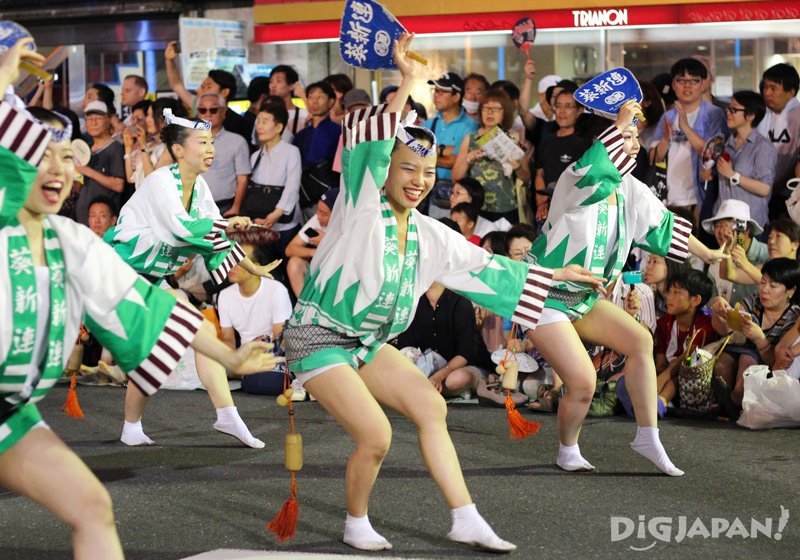
Dancers may wear a yukata or a happi coat. As I learned during the workshop, they keep this low stance throughout the dance. This makes a big contrast with the tall figures of the onna odori.

They often hold uchiwa fans, turning them around in their hands as they dance.

My favorite dancers are the ones who use these lanterns. Their movements look really complex and they are hypnotic to watch.

Instead of geta, men wear odori tabi. They are split-toe socks with a rubber bottom. I've always wanted to try them. They look way more comfortable than the women's geta.
■Narimono, the Musicians
At the end of the Ren are the musicians playing the Awa Odori music. Here are the most common instruments that you can see in each group.

Shamisen players usually come first. A shamisen is a three-stringed traditional Japanese instrument.

The fue (flute) is the melody of the dance. Its sound can be heard from a distance over all the bustle.

Another important instrument is the kane. This small gong dictates the rhythm of the dance, speeding up and slowing down to change the way people dance.

This small drum is called shime-daiko. Every player has a different style.

Lastly, o-daiko is a big drum that makes a booming sound. O-daiko players are generally the most sweaty of the bunch, and they often show off with powerful and crazy 'solos'.

These are our Ren's drummers! They're giving it all they have at the end of the parade.

Sometimes the music will pick up and dancers break ranks, dancing more vigorously and trying to get the attention of the audience, who cheers in response.

You'll sometimes also see dancers wearing funny masks like the hyottoko, a comical Japanese character.

Being a matsuri (festival), Awa Odori is packed with stalls selling delicious festival food. Hikawa Shrine is where the most yatai stalls are concentrated.

Have you ever tried Ramune? It's a kind of soft drink that is considered a symbol of summer in Japan. I was very thirsty after the dance, so I grabbed this blue one to match the color of my happi coat.

My favorite yatai are these vintage ones. You have to play an old mechanical game to see how many of whatever they're selling you will get. This person just won two sweets!

Many restaurants and bars set up makeshift tables for matsuri-goers to sit outside. If you visit Japan in summer, you can't miss the experience of balancing your drink on a wooden board while sitting on a beer case, chatting with some lively locals.

And now you're an Awa Odori expert! This is definitely my favorite Japanese festival. It's lively, it's colorful, and gets together people of all ages and nationalities. I love seeing Japanese people in their element and having fun, rather than running around in a suit to catch the last train. Also, it is truly beautiful to see them so happy to share their traditions with us.
Schedule: Last weekend of August 5:00pm-8:00pm (rain or shine)
Address: Shopping streets around the North and South Exit of JR Koenji Station, Suginami, Tokyo
Access: 0 min. walk from Koenji Station on the JR Chuo Main line. 5 min. walk from Shin-Koenji Station on the Tokyo Metro Marunouchi line
Website: http://www.koenji-awaodori.com/language/eng.html
Awa Odori dance experience info
Breathe Tokyo
Website: https://www.breathetokyo.jp/events/culture-2017-8-27
※This article is based on a coverage made in August 2017.
※The event schedule and other information are subject to change every year.
About the author
Laura is an Italian living and working in Tokyo. She loves exploring hidden and unknown places, taking pictures and listening to Punk Rock music. When she’s not busy doing the above, she might enjoy a craft beer or play the sanshin (an Okinawan instrument similar to a shamisen).
The watchers are fools
Both are fools alike so
Why not dance?
(Awa yoshikono, the Awa Odori song)
Every summer, over 10,000 dancers and over 1 million people gather in the streets of Koenji for the annual Awa Odori festival. This is one of the biggest, most lively and colorful festivals in Tokyo.

I have seen Awa Odori twice before, but I wanted to learn more about it. This year I had the chance to participate in an event organized by Breathe Tokyo that gives foreigners the possibility to join one of the dance groups. Here's my experience and what I learned about Awa Odori in the process!
What is Awa Odori?

Awa Odori or Awa dance originated in the Tokushima prefecture (formerly called Awa) back in 1587. There are several theories about the origin of this dance, many of which stating that it evolved from other folk dances. The most popular theory recounts of Hachisuka Iemasa, a feudal lord who threw a big party for the newly built Tokushima castle in 1587. Allegedly, so much sake was present at this party that the citizens started to dance in the streets, giving origin to Awa Odori. Regardless of this story being true or not, this is a festival worth seeing. Nowadays many other cities in Japan are holding their own Awa Odori festival so you might catch one if you visit Japan in summer.
The Origin of Koenji Awa Odori

The district of Koenji in Suginami ward adopted this festival back in 1957 to revitalize its streets. The Koenji Awa Odori is held every year on the last weekend of August and it is now the second largest Awa Odori festival in Japan. During the festival, groups of dancers called Ren parade through the streets around the station.

Any business in the area, no matter if it's a restaurant or a dry cleaner, will set up a little stand outside their shop selling food or drinks. The streets become lively with people eating and drinking and with the music from the parade.
The Basic Dance
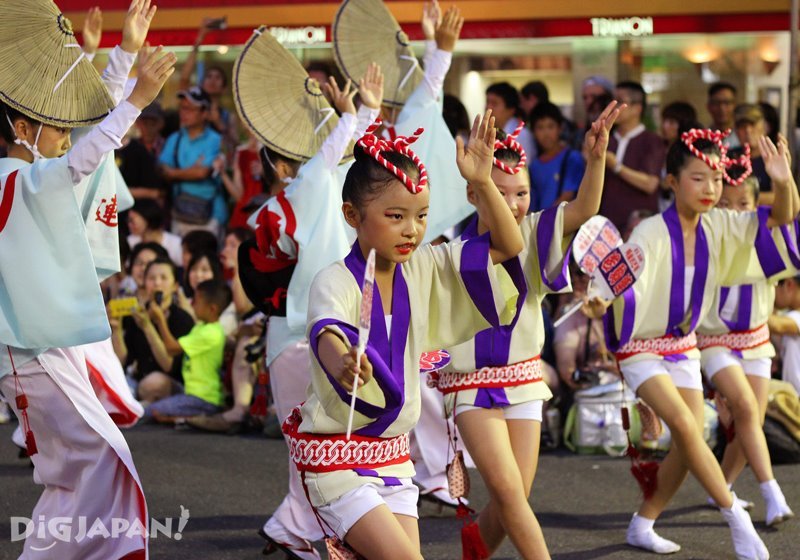
So there I was, a few hours before the dance started, joining the workshop organized by Breathe Tokyo and learning the basics of the Awa dance.
There are several dancing styles in Awa Odori. We learned the most basic one, which can be danced by both men and women. It's basically a step-return pattern alternating between your right and left foot. I always thought this dance looked very easy and carefree, but it actually takes some strength and coordination.

First we were taught the basic position which is a squatting stance. Yes, you have to keep in this position throughout the whole dance!

Then we learned how to coordinate our steps with the movement of our arms. When your right foot goes forward, so does your right arm and vice versa.

We practiced for a while, adding in the traditional Awa Odori calls. When one of the dancers calls "yatto sa?" we all respond "a, yatto, yatto!"

We were wearing a very pretty blue happi coat. The Japanese members of the group helped us put on all our gear and get ready for the show.

Ta-dah! And now we're ready to dance in front of thousands of people. Maybe.

Here's how Awa Odori looks from the inside. It was a bit tricky to take pictures and dance at the same time, but I managed a few shots.
Inside a Ren
Each Ren, or dancing group, is unique. The number of dancers, the dancing style and the color of the clothing vary for each group. The marching order is usually the same. The group is led by a person holding a big lantern. After the lantern come the children (if any), women, men, and musicians at the end.
■Takahari Lantern

One or more dancers lead the Ren carrying a tall lantern. This lantern bears the name of the group.

Here is our takahari! The carrier let me hold it before the dance, it wasn't terribly heavy but it felt very difficult to balance.

Some lantern carriers just walk, other dance, and some even manage to swing the lantern around.
■Onna Odori, the Woman Dance

This dance is performed by women only. They dance in a romantic way that shows grace and elegance.

The dancers wear a straw hat called amigasa. It makes them look taller, and sometimes hides their eyes. It's quite impressive to see large groups of dancers all keeping their hat at the same angle.

The whole time, they are dancing on the tip of their toes wearing black geta sandals. This must be very hard but they make it look natural and graceful.

Onna odori dancers wear yukata, a light summer kimono. The colors range from light pastel tones to very bright and flashy.
■Otoko Odori, the Man Dance

While onna odori is exclusively danced by women, otoko odori can be danced by both. It's a more dynamic, sometimes silly dance that shows off the strength and vigor of men.

Dancers may wear a yukata or a happi coat. As I learned during the workshop, they keep this low stance throughout the dance. This makes a big contrast with the tall figures of the onna odori.

They often hold uchiwa fans, turning them around in their hands as they dance.

My favorite dancers are the ones who use these lanterns. Their movements look really complex and they are hypnotic to watch.

Instead of geta, men wear odori tabi. They are split-toe socks with a rubber bottom. I've always wanted to try them. They look way more comfortable than the women's geta.
■Narimono, the Musicians

Our Ren's narimono
At the end of the Ren are the musicians playing the Awa Odori music. Here are the most common instruments that you can see in each group.

Shamisen players usually come first. A shamisen is a three-stringed traditional Japanese instrument.

The fue (flute) is the melody of the dance. Its sound can be heard from a distance over all the bustle.

Another important instrument is the kane. This small gong dictates the rhythm of the dance, speeding up and slowing down to change the way people dance.

This small drum is called shime-daiko. Every player has a different style.

Lastly, o-daiko is a big drum that makes a booming sound. O-daiko players are generally the most sweaty of the bunch, and they often show off with powerful and crazy 'solos'.

These are our Ren's drummers! They're giving it all they have at the end of the parade.

Sometimes the music will pick up and dancers break ranks, dancing more vigorously and trying to get the attention of the audience, who cheers in response.

You'll sometimes also see dancers wearing funny masks like the hyottoko, a comical Japanese character.
Don't Miss the Yatai!

Being a matsuri (festival), Awa Odori is packed with stalls selling delicious festival food. Hikawa Shrine is where the most yatai stalls are concentrated.

Have you ever tried Ramune? It's a kind of soft drink that is considered a symbol of summer in Japan. I was very thirsty after the dance, so I grabbed this blue one to match the color of my happi coat.

My favorite yatai are these vintage ones. You have to play an old mechanical game to see how many of whatever they're selling you will get. This person just won two sweets!

My first Awa Odori back in 2013
Many restaurants and bars set up makeshift tables for matsuri-goers to sit outside. If you visit Japan in summer, you can't miss the experience of balancing your drink on a wooden board while sitting on a beer case, chatting with some lively locals.
Discover the Tradition and Join the Fun

And now you're an Awa Odori expert! This is definitely my favorite Japanese festival. It's lively, it's colorful, and gets together people of all ages and nationalities. I love seeing Japanese people in their element and having fun, rather than running around in a suit to catch the last train. Also, it is truly beautiful to see them so happy to share their traditions with us.
Information
Tokyo Koenji Awa Odori | 東京高円寺阿波踊りSchedule: Last weekend of August 5:00pm-8:00pm (rain or shine)
Address: Shopping streets around the North and South Exit of JR Koenji Station, Suginami, Tokyo
Access: 0 min. walk from Koenji Station on the JR Chuo Main line. 5 min. walk from Shin-Koenji Station on the Tokyo Metro Marunouchi line
Website: http://www.koenji-awaodori.com/language/eng.html
Awa Odori dance experience info
Breathe Tokyo
Website: https://www.breathetokyo.jp/events/culture-2017-8-27
※This article is based on a coverage made in August 2017.
※The event schedule and other information are subject to change every year.
About the author
Laura is an Italian living and working in Tokyo. She loves exploring hidden and unknown places, taking pictures and listening to Punk Rock music. When she’s not busy doing the above, she might enjoy a craft beer or play the sanshin (an Okinawan instrument similar to a shamisen).

Liked this story? Like DiGJAPAN!
on Facebook for daily updates!
THIS ARTICLE IS BASED ON INFORMATION FROM 09 08,2017 Author:DiGJAPAN! Editorial Team













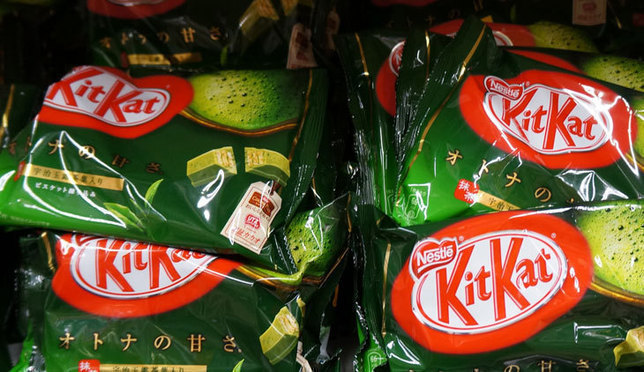


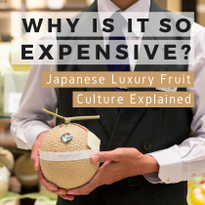





NEW COMMENT | 0 COMMENTS
Open a DiGJAPAN!
account to comment.
Open a DiGJAPAN! Account